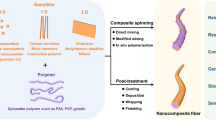Abstract
An infinite cylinder model was used to predict the optical transmission of transparent composites containing unidirectionally aligned glass fibers. The parameters used in the model are the volume content and diameter of the glass fibers, the refractive index of the fiber and matrix, the nonwet fiber content, the thickness of the composite, and the temperature coefficient of the refractive index of the matrix. The transmission calculated from the model agreed well with the measured temperature-dependent transmission of a composite from 20 to 70 °C for thin specimen (<1.0 mm) containing fiber less than 10 vol. %. The model showed that a small amount of nonwet fiber (0.7% of fiber content) could cause a substantial reduction in the maximum transmission. The content of nonwet fibers should be as small as possible for making a highly transparent composite.
Similar content being viewed by others
References
D. Marcuse Light Transmission Optics (Van Nostrand Reinhold Company Inc., New York, 1982).
H. Lin D.E. Day and J.O. Staffer Polym. Eng. Sci. 32, 344 (1992).
H. A. Robinson R. Ruggy and E. Slantz J. Appl. Phys. 15, 343 (1944).
P. Michel J. Dugas J. M. Cariou and L. Martin J. Macromol. B 25, 379 (1986).
Polymer Handbook, 2nd ed., edited by J. Brandrup and E. H. Immergut (John Wiley & Sons, New York, 1975).
J. M. Cariou J. Dugas L. Martin and P. Michel Appl. Opt. 25, 334 (1986).
Optical Glass, Schott Glass Technologies Inc., Duryea, PA (1982).
H. C. van de Hulst, Light Scattering by Small Particles (John Wiley & Sons, New York, 1957).
C. F. Bohren and D. R. Huffman Absorption and Scattering of Light by Small Particles (John Wiley & Sons, New York, 1983).
M. Born and E. Wolf Principles of Optics (Pergamon Press, New York, 1959).
Ye.V. Chistyakov O. S. Arkhireyev and B.M. Zetev Polym. Sci. U.S.S.R. 26, 2116 (1984).
B.E. Read J. Polym. Sci. C 16, 1887 (1967).
Author information
Authors and Affiliations
Rights and permissions
About this article
Cite this article
Lin, H., Day, D.E. & Stoffer, J.O. Model for the temperature dependent transmission of optically transparent poly(methyl methacrylate) composites. Journal of Materials Research 8, 364–370 (1993). https://doi.org/10.1557/JMR.1993.0364
Received:
Accepted:
Published:
Issue Date:
DOI: https://doi.org/10.1557/JMR.1993.0364




